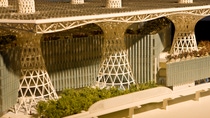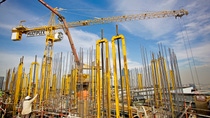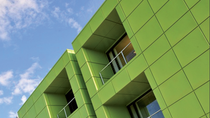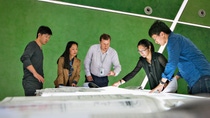Future of sustainable construction
Against the challenges of the growing population and resource scarcity, what is the ideal living environment for urban dwellers? What are the development opportunities of sustainable constructions and eco-cities in China?

Located 17 kilometers from the capital Abu Dhabi, Masdar City has a couple of nicknames such as Middle East Sun City, Zero Carbon Ark, Utopia in Desert, etc. Why the six-square-kilometer city still under construction is given so many beautiful titles?
That is because it’s regarded as a model of future cities.
Established in the desert with an average temperature of 40 to 50 centi-degrees and with 100 billion barrels of oil hidden underground, Masdar City will not consume a drop of oil, with an ultimate goal of realizing “zero carbon, zero emissions”. Through ingenious design, the average temperature of Masdar City can be 20 centi-degrees lower than outside; the energy used in the buildings completed thus far comes entirely from renewable sources; and solar energy will account for 80% of the city’s energy supply. Currently, the power supply of this city still under construction is generated by a 10 megawatt solar power plant in the desert.
In order to live up to its pioneering role, Masdar has partnered with leading companies, including BASF. It is aimed to be built as a role model of eco city that provides the world with inspirations and best practices in respect of sustainable constructions and smart transportation solutions, etc.

Along with the irreversible urbanization trend, many challenges are increasingly inescapable. The current global population living in cities is already larger than that living in rural areas. By 2050 it is estimated that 75% of us will be urban dwellers. How do we curb the urban sprawl that has afflicted some of the world’s megacities? And how can power consumption be reduced in cities, which currently consume over two-thirds of the world’s energy? Buildings play a principal role in cities and are energy guzzlers. They account for one-third of energy consumption in metropolises globally.
Under the energy challenge, sustainability will undoubtedly become the biggest trend of future constructions. The philosophy of sustainable constructions is to reduce environmental impact, to harmoniously co- exist with the surroundings, and to benefit people’s health. That’s why the buildings are designed to reduce energy consumption, conserve water, reduce pollution and protect health. Passive house is a typical example of sustainable constructions, of which the ultimate goal is “zero carbon, zero emissions” and comfortable living demonstrated by Masdar City.
Governments have already introduced policies to support sustainable constructions. According to the latest Europe Union (EU) regulations, after 2020, any new housing that fails to meet the standard of passive house will not be granted with a construction permit. That means ever since 2020, all new buildings in EU countries will be passive constructions. European countries have also introduced more specific measures. For example, the German government requires all new buildings to achieve "zero emissions" by 2020. Sweden also requires that its new constructions should completely get away from reliance on fossil fuels.
Sustainable architecture will not only save energy, but also provide a comfortable environment for people. Skyscrapers are a sign of modern city. Although they have been lauded and criticized in equal measure, it’s undeniable that this leap in scale is necessary to prevent urban sprawl and help cut emissions. Skyscrapers help enlarge the capacity of cities by several times, while shortening people’s transportation distance. In addition, the centralized design of skyscrapers can help a city in energy saving.
Functionally, skyscrapers are transforming from the previous business premises into more diversified comprehensive function body. Shard London is a "vertical village" of residences, restaurants, offices and hotels; Shanghai Tower, the tallest building in China to be completed also integrates restaurants, cafes, shops, gardens and other open public spaces. These building facilities are built for people to work, rest, have fun and socialize in. The old habits of walking out of the office to have a cup of coffee or eat something on street will gradually be replaced by the simple moves of walking into elevator, selecting a floor upstairs or downstairs to the nearest cafe or gym.
During the three decades after reform and opening up, China has witnessed the fastest urbanization process in the world. China’s urban population has increased from 170 million to 710 million in 2012, with the urbanization rate growing from 17.9% in 1978 to 52.6% in 2012. By 2020, China will become one of the high-income countries. According to the growth trend, China’s urbanization rate will continue to grow in the next one or two decades towards 75% or 80%.
“On the one hand, China’s urbanization process brings opportunities to the construction industry; on the other hand, we must trade quality for speed to make the new buildings more sustainable, ” said Dr. Qu Cuisong, Associate Professor of College of Architecture and Urban Planning, Tongji University. According to the official data, China boasts the largest new construction volume every year in the world. However, the average life expectancy of real estate is only about 30 years.
Cities in China have more pressing needs for sustainable buildings. According to a research by Chinese Department of Construction Science and Technology Division, energy consumption of the buildings in China increased year by year in total energy consumption, currently accounting for about one-third of the latter. In recent years, China is at the peak of its building wave, with the annual floor space built being 1.6 to 2 billion square meters, exceeding the sum of annual completed construction area in all developed countries. Among them, more than 97% are high- energy-consumption buildings.
According to Qu, China faces three challenges in developing sustainable buildings: firstly, buyers’ moderate concern about housing quality leads to a low weight of housing quality among price factors.
Secondly, environmental awareness of user groups holding high-end properties is to be enhanced, as currently they are still the groups consuming the highest amount of resources and energy in China. Thirdly, there have been inadequate supporting policies, which lead to a lack of motivation for developers.
Sustainable buildings will play an influential role in reducing urban energy consumption. Taking today’s passive house in Germany for example, its energy consumption per square meter is only one-fourth of ordinary buildings. The Chinese government is also actively promoting the development of energy- efficient buildings, proposing that by 2020 the energy consumption for new buildings should be 75% lower.
In fact, China has no lack of real estate developers who are conscious of sustainability and have made outstanding achievements in this field. Landsea Group Co., Ltd. (Landsea) is an example of that. Through continuous investment in research and development for sustainable buildings, Landsea has become a unique existence in real estate industry. “Our planet will benefit greatly from a sustainable China,” said Xie Yuanjian, vice president of Landsea. “We have built many sustainable buildings that can provide occupants with comfortable living environment of perennial constant temperature and humidity. Moreover, through using thermal insulation solutions and ground source heat pump technologies, they are more energy efficient and environmentally friendly than ordinary constructions.” In over a decade, Landsea was able to achieve the balance of economic and ecological benefits and more than 30% of its buyers are returned customers.
“Our planet will benefit greatly from a sustainable China.”
Xie Yuanjian, Vice President of Landsea Group Co., Ltd.
“We are working hand in hand with real estate developers to realize our vision for sustainable constructions in China.”
Dr. Daqing Zheng, Senior Vice President, Business and Market Development, Greater China, BASF
BASF is an active advocator of sustainable constructions and a leading global provider of energy-saving construction materials and solutions. “Building materials of excellent quality can offer many benefits, for example increasing housing durability, reducing maintenance effort, improving energy efficiency, as well as shortening construction period and saving labor costs,” said Dr. Zheng Daqing, Senior Vice President, BASF.
“BASF has formed into great partnership with Chinese real estate developers in China. We’ve also witnessed the perception change of Chinese developers and users,” said Zheng. “More and more developers and builders started to choose high-quality materials and the public’s awareness of construction quality is increasing. We are working hand in hand with real estate developers to realize our vision for sustainable constructions in China.”
Perception change is the beginning of all transitions. China has a huge potential consumer market for sustainable building and is the largest manufacturer and consumer of solar, wind and other alternative energy equipment. More and more building materials manufacturers are moving towards sustainability. These are all the facts that lay the foundation of a future ecological city. More importantly, Chinese cities are changing the previous GDP-oriented growth mode, and "sustainable building" will become the most important city signature.



